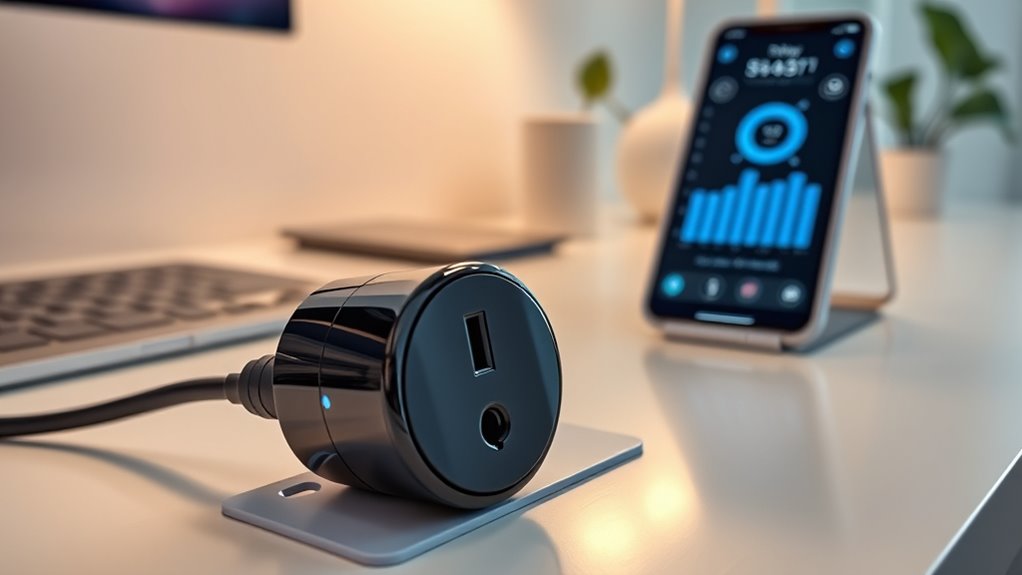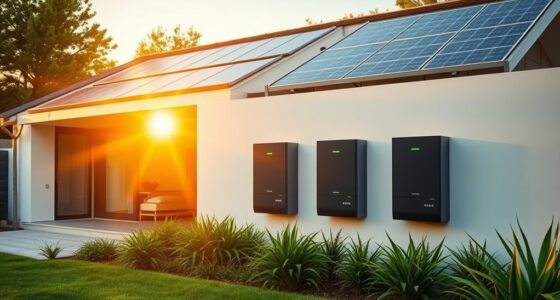If you’re looking to cut energy costs in 2025, I recommend checking out the top smart plugs with energy monitoring. These devices not only let you control your appliances remotely but also track power usage to identify waste. Models like the TP-Link Tapo, Emporia, and Kasa provide great features for affordability and detailed data. Continue exploring, and you’ll find the perfect options to help you save power efficiently.
Key Takeaways
- Choose smart plugs with built-in energy monitoring for real-time tracking and historical usage insights to optimize power consumption.
- Opt for models supporting multi-platform ecosystems (Alexa, Google, Apple) for seamless automation and control.
- Consider safety features like surge protection, overload safeguards, and certifications to ensure secure operation.
- Select compact, weather-resistant designs suitable for indoor and outdoor use to expand your smart home effectively.
- Prioritize plugs offering scheduling, automation, and remote control features to maximize energy savings in 2025.
KTMC Smart Plug 4 Pack with Alexa & Google Compatibility
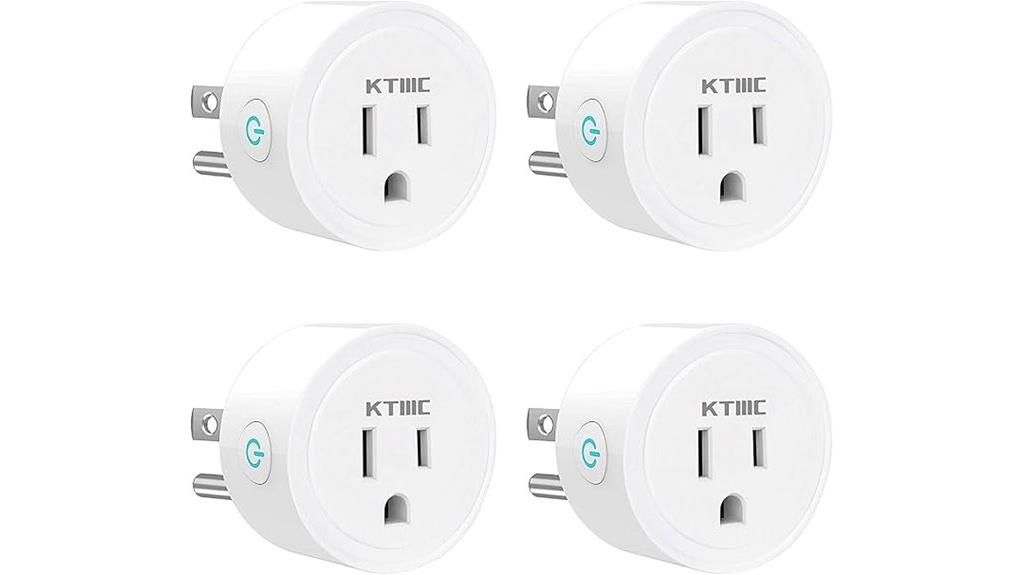
If you’re looking for an affordable and easy-to-use smart plug that works seamlessly with both Alexa and Google Assistant, the KTMC Smart Plug 4 Pack is a top choice. I love how it requires no hub—just plug it in, connect via the Smart Life app, and you’re ready to go. Its compact design prevents blocking other outlets, and the flame-retardant material guarantees safety. You can control appliances remotely, set schedules, timers, or activate “Away Mode” for energy savings and security. Voice commands like “Alexa, turn on the lamp” make control effortless. Plus, with solid reviews and certification, it’s reliable and perfect for home automation.
Best For: homeowners seeking an affordable, easy-to-install smart plug compatible with both Alexa and Google Assistant for remote control and automation.
Pros:
- No hub required; easy setup via Smart Life app
- Compact design prevents blocking adjacent outlets
- Supports scheduling, timers, and “Away Mode” for energy savings
Cons:
- Only compatible with 2.4GHz Wi-Fi networks
- Limited to controlling compatible household appliances
- May require internet connection for remote access
Linkind Matter Smart Plug (4 Pack)
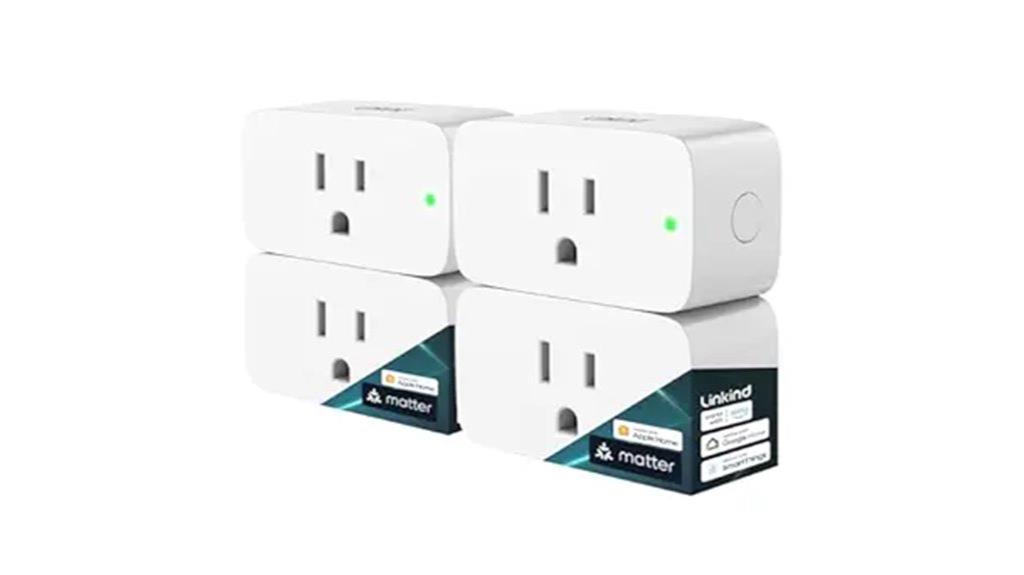
The Linkind Matter Smart Plug (4 Pack) stands out as an excellent choice for those seeking seamless integration across multiple smart home platforms. It supports Apple Home, Siri, Alexa, Google Assistant, SmartThings, and AiDot, eliminating the need for multiple apps. Certified with Matter, it works with hubs like HomePod, Echo Dot, Nest, or can be controlled via the AiDot app without a hub. The compact, fire-resistant design handles up to 1800W and features protections against short circuits and overloads. Reliable over 2.4GHz Wi-Fi and IPv6 networks, it offers easy setup, voice control, automation routines, and offline functionality—making it a versatile, safe smart plug for any home.
Best For: smart home enthusiasts seeking reliable, versatile, and easy-to-integrate smart plugs compatible with multiple voice assistants and platforms.
Pros:
- Supports multiple platforms including Apple Home, Siri, Alexa, Google Assistant, SmartThings, and AiDot, simplifying control and automation.
- Matter-certified and compatible with major hubs like HomePod, Echo Dot, Nest, or controllable via the AiDot app without additional hubs.
- Compact, durable, and safe design with protections against short circuits and overloads, suitable for various household devices.
Cons:
- Only supports 2.4GHz Wi-Fi and IPv6 networks, which may require router updates or reconfiguration.
- Initial setup can be challenging for non-tech-savvy users, especially when integrating with multiple automation systems.
- Some users report minor issues such as delayed device registration or difficulty syncing with routines across different platforms.
TP-Link Tapo Smart Plug Wi-Fi Mini (2-Pack)
https://m.media-amazon.com/images/I/516P58ZHCSL._AC_SX679_PIbundle-2,TopRight,0,0_SH20_.jpg
The TP-Link Tapo Smart Plug Wi-Fi Mini (2-Pack) stands out for its energy monitoring capabilities, making it an excellent choice for anyone looking to optimize their energy usage and reduce electricity bills. It offers clear, easy-to-understand usage stats and intuitive charts, helping you track your power consumption accurately. The plug supports scheduling to run high-energy devices during off-peak hours, saving money. With auto-shutoff and power cut-off features, it ensures safety and prevents overloads. Compatible with Alexa, Google Home, and Samsung SmartThings, you can control your devices remotely or via voice commands for added convenience.
Best For: those seeking an energy-efficient, safe, and convenient smart plug solution to monitor and control their devices remotely.
Pros:
- Provides detailed energy usage statistics and intuitive charts for easy monitoring
- Supports scheduling and auto-shutoff features to optimize energy consumption and enhance safety
- Compatible with popular voice assistants like Alexa, Google Home, and Samsung SmartThings for remote control
Cons:
- Only supports 2.4 GHz Wi-Fi networks, limiting compatibility with some routers
- Requires a stable Wi-Fi connection for optimal performance
- Limited to 15A/1800W maximum load, which may not suit high-power appliances
SIEMENS Inhab Smart Home Energy Monitor
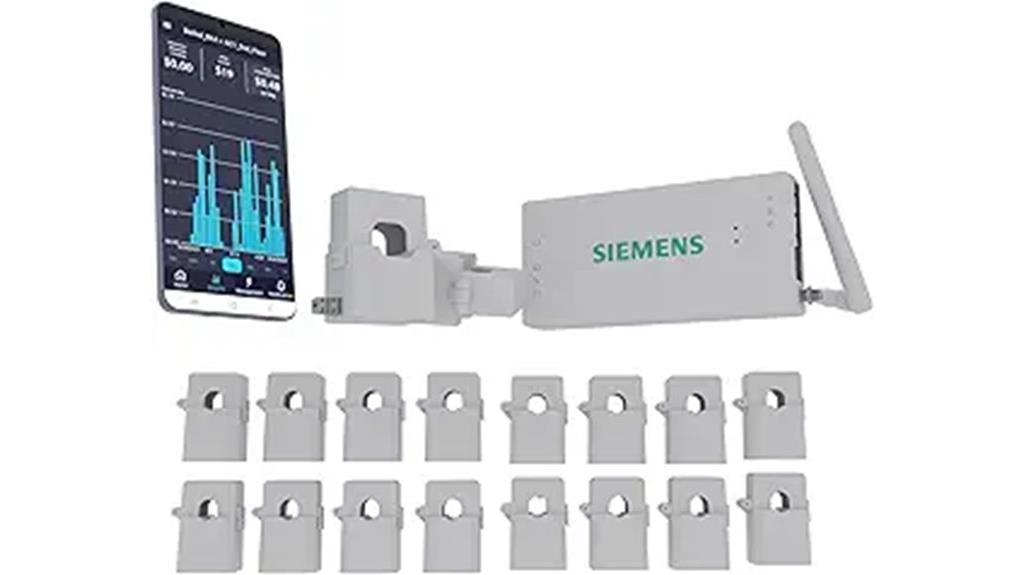
Homeowners interested in detailed energy tracking will find the Siemens Inhab Smart Home Energy Monitor an excellent choice. It installs directly in your electrical panel, monitoring up to 16 circuits with easy-to-install CT sensors, and offers real-time data through a cloud-connected app. You can track current and historical usage, identify high-demand appliances, and optimize energy efficiency. The system supports advanced features like peak demand control, solar management, and load shedding. While installation requires a licensed electrician, it provides in-depth insights into your home’s energy patterns, helping you make smarter choices and potentially save money on power bills.
Best For: homeowners seeking detailed, real-time energy monitoring and management to optimize efficiency and reduce costs with professional installation.
Pros:
- Provides comprehensive real-time and historical energy data through an intuitive app.
- Supports advanced features like peak demand control, solar management, and load shedding.
- Compatible with existing and new electrical panels, with detailed circuit-level monitoring.
Cons:
- Installation requires a licensed electrician, which may add to upfront costs.
- Limited number of current transformers may restrict monitoring capacity for larger panels.
- Short Wi-Fi antenna leads and wiring challenges can complicate installation in tight spaces.
TP-Link Tapo Smart Plug 4-Pack, Wi-Fi Mini with Energy Monitoring
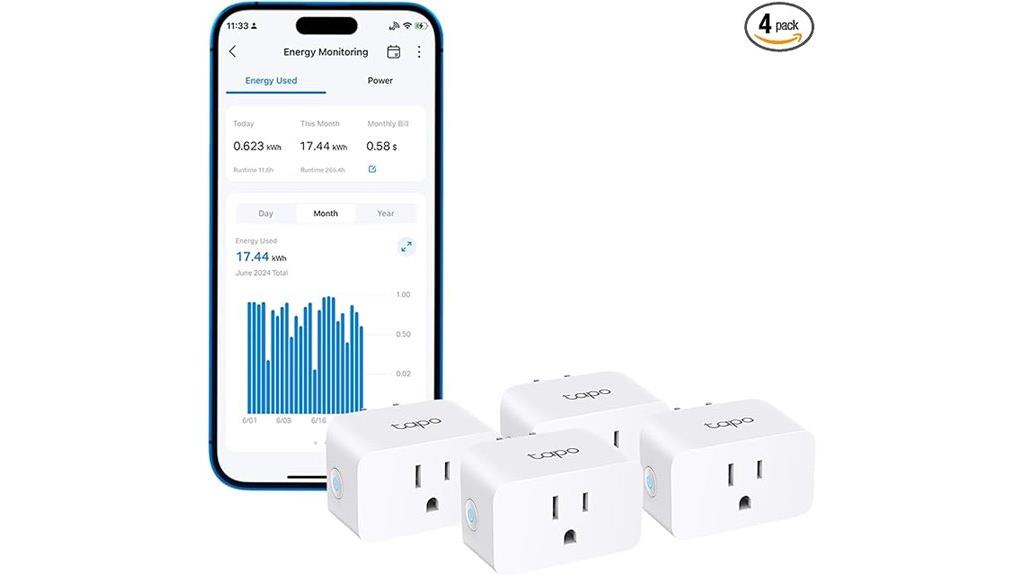
If you want an affordable way to monitor energy consumption across multiple devices without sacrificing convenience, the TP-Link Tapo Smart Plug 4-Pack is an excellent option. It offers clear energy statistics and intuitive charts, helping you track power use accurately and estimate electricity costs. You can schedule devices to run during off-peak hours, saving money, and set auto-shutoff to prevent overloads. Compatible with Alexa, Google Assistant, and Samsung SmartThings, it allows remote control via the Tapo app. Its compact design fits well in tight spaces, making it a practical choice for automating and managing energy in your smart home.
Best For: homeowners and tech enthusiasts seeking comprehensive energy monitoring and smart device control across multiple appliances with easy setup and compatibility with popular voice assistants.
Pros:
- Accurate energy monitoring with clear statistics and intuitive charts
- Supports scheduling, timers, and auto-shutoff features for energy efficiency and safety
- Compatible with Alexa, Google Assistant, and Samsung SmartThings for seamless voice and remote control
Cons:
- Larger size compared to mini plugs, which may limit placement in tight spaces
- Slightly higher price point than basic mini plugs without energy monitoring
- Requires 2.4GHz Wi-Fi connection and may not be suitable for users with only 5GHz networks
Kasa Matter Smart Plug with Energy Monitoring (4-Pack)
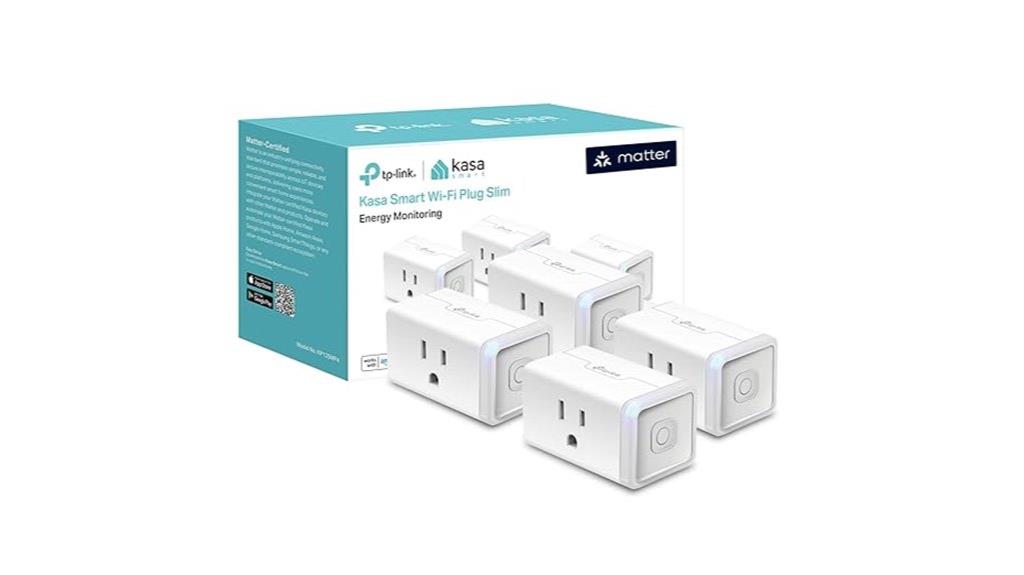
For those seeking a versatile and future-proof smart plug, the Kasa Matter Smart Plug with Energy Monitoring (4-Pack) stands out as an excellent choice. Supporting the Matter protocol, it guarantees seamless compatibility across platforms like Apple Home, Alexa, Google Home, and Samsung SmartThings, all without needing a hub. Its compact, weather-resistant design makes it perfect for indoor and outdoor use, while energy monitoring helps track power consumption to lower bills. Easy to set up with step-by-step instructions, it offers app control, voice commands, and manual operation. Reliable and durable, this pack is ideal for expanding your smart home ecosystem and enhancing energy efficiency.
Best For: smart home enthusiasts seeking a reliable, future-proof, and versatile smart plug that integrates seamlessly across multiple platforms and supports both indoor and outdoor use.
Pros:
- Supports the Matter protocol for effortless cross-platform compatibility including Apple Home, Alexa, Google Home, and Samsung SmartThings.
- Compact, weather-resistant design suitable for outdoor and indoor applications, with easy setup and manual control options.
- Energy monitoring feature helps track power consumption, enabling users to save on energy bills.
Cons:
- Requires a stable Wi-Fi connection for optimal performance; may experience issues in areas with weak signals.
- Initial setup, while straightforward, may still pose slight challenges for very new smart home users.
- Limited to 15A/1800W maximum load, which may not suffice for high-power appliances.
Emporia Energy Monitoring Smart Plug (4 Pack)
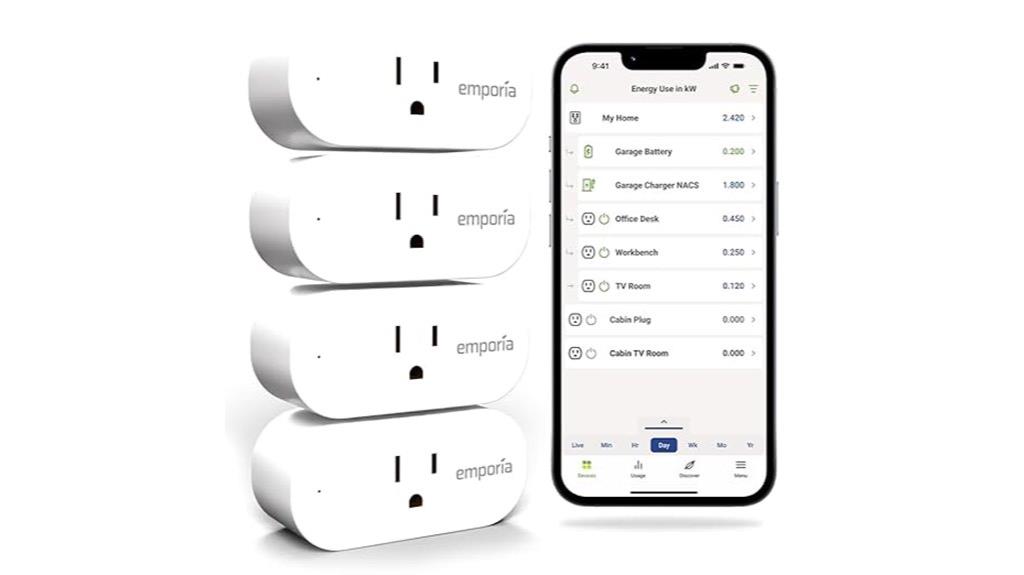
The Emporia Energy Monitoring Smart Plug (4 Pack) stands out as an excellent choice for those looking to monitor and control multiple devices remotely. I appreciate its WiFi connectivity, compatible with Alexa and Google Home, making voice control effortless. With the Emporia App, I can turn devices on or off from anywhere, which is perfect for managing lights, fans, or appliances. It also tracks energy consumption, helping me identify waste and save on bills. Plus, I can schedule devices to turn on or off automatically, boosting efficiency. Just keep in mind, it works only on 2.4GHz WiFi networks and supports loads up to 10A continuously.
Best For: homeowners and renters seeking an easy way to remotely monitor and control multiple household devices for energy savings and convenience.
Pros:
- Compatible with Alexa and Google Home for voice control
- Allows remote operation via the Emporia App from anywhere with internet access
- Helps track energy consumption to identify waste and reduce bills
Cons:
- Only supports 2.4GHz WiFi networks, not 5.0GHz
- Limited to a maximum continuous load of 10A, which may not suit high-power appliances
- Requires a WiFi connection for remote control and scheduling features
meross Matter Smart Plug (4 Pack)

The meross Matter Smart Plug (4 Pack) stands out for its broad multi-platform compatibility and seamless setup, making it ideal for households with multiple smart ecosystems. It supports Apple HomeKit, Alexa, Google Home, and SmartThings, ensuring effortless interoperability. Setup is a breeze—just plug it in, turn on your Echo, and ask to find the device for automatic connection, or pair manually if needed. It works exclusively over 2.4GHz Wi-Fi with IPv6, requiring a Matter-compatible hub. With built-in energy monitoring, you can track real-time and historical power use via the Meross app. Plus, it offers privacy-focused LAN control and voice command support for convenient, secure operation.
Best For: households seeking a versatile, secure, and easy-to-setup smart plug compatible with multiple smart home platforms and energy monitoring features.
Pros:
- Supports broad multi-platform compatibility with Apple HomeKit, Alexa, Google Home, and SmartThings.
- Seamless zero-touch setup with Echo and manual pairing options.
- Built-in energy monitoring and privacy-focused LAN control ensure secure, informed device management.
Cons:
- Only operates over 2.4GHz Wi-Fi with IPv6; does not support Thread.
- Requires a Matter-compatible hub for platform integration.
- Limited to 15A/1800W capacity, which may not suit high-power appliances.
EIGHTREE Smart Plug, WiFi Outlet with Alexa & Google Home Compatibility (4 Pack)
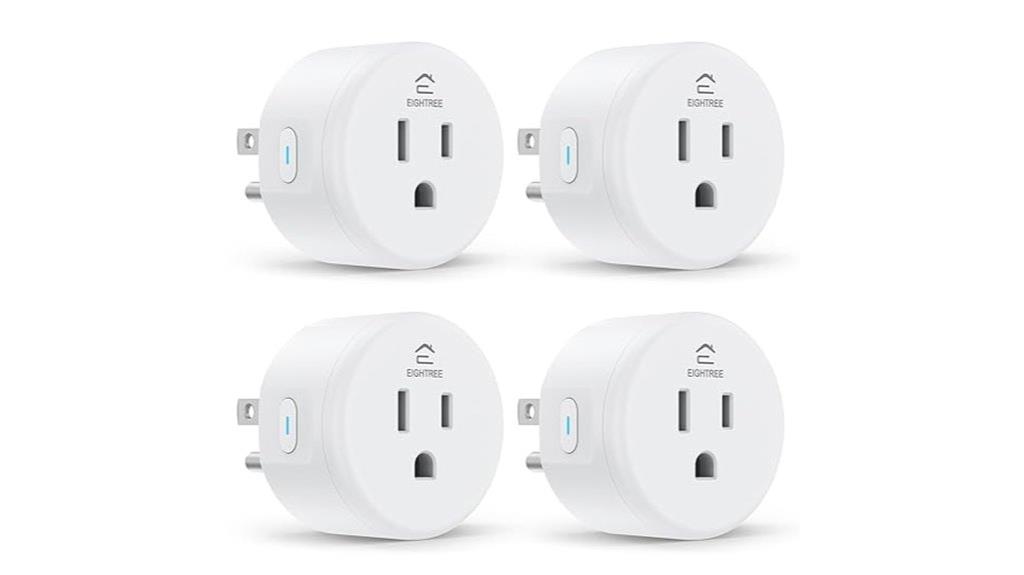
If you’re looking to control multiple devices effortlessly while monitoring energy use, the EIGHTREE Smart Plug, WiFi Outlet with Alexa and Google Home Compatibility (4 Pack) is a great choice. It connects via 2.4GHz WiFi and works seamlessly with Alexa, Google Home, and SmartThings. Setup is straightforward with the Smart Life app, which detects devices via Bluetooth. You can control outlets remotely, create schedules, and set timers for automatic operation. While the compact design saves space, some outlets may be limited when using larger adapters. Overall, users praise its reliability and ease of use, making it a versatile addition for smart home energy management.
Best For: smart home enthusiasts seeking easy, reliable control of multiple devices with energy monitoring and scheduling capabilities.
Pros:
- Compatible with Alexa, Google Home, and SmartThings for seamless voice and app control
- Easy setup via the Smart Life app with Bluetooth device detection
- Compact design saves space and supports remote operation from anywhere
Cons:
- Limited to 2.4GHz WiFi, not supporting 5GHz networks directly
- Bulky size may block adjacent outlets, especially with larger adapters
- Some users report hardware issues or device failures over time
Emporia Energy Monitoring Smart Plug (4 Pack)
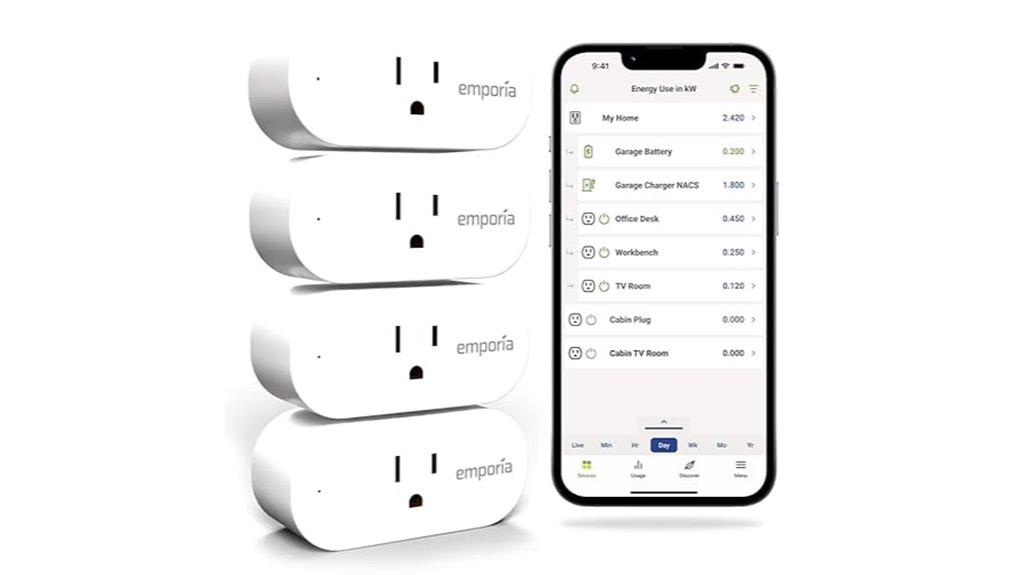
Looking for an affordable way to monitor multiple devices simultaneously? The Emporia Energy Monitoring Smart Plug (4 Pack) is perfect for that. Compatible with Alexa and Google Home, it connects via 2.4GHz WiFi, allowing remote control through the Emporia App. You can easily turn devices on or off from anywhere, making managing lights, fans, or appliances simple. Plus, it tracks energy usage, helping you identify waste and cut costs. With built-in scheduling, you can automate device operation to save even more. Designed for 120V outlets with a 10A continuous load, it offers a reliable, easy way to boost energy efficiency across your home.
Best For: homeowners and renters seeking an affordable, easy way to monitor and control multiple household devices remotely and improve energy efficiency.
Pros:
- Easy remote control via smartphone app for convenience from anywhere
- Energy monitoring features help identify waste and reduce electricity bills
- Supports automation with built-in scheduling to optimize device usage
Cons:
- Only compatible with 2.4GHz WiFi networks; does not support 5.0GHz
- Limited to a maximum continuous load of 10A, which may not suit high-power appliances
- Requires a stable internet connection for remote access and control
Emporia Energy Monitor with Sensors & Smart Plugs Bundle

For homeowners seeking thorough energy management, the Emporia Energy Monitor with Sensors & Smart Plugs Bundle offers an all-in-one solution. It includes the Emporia Vue Energy Monitor with 16 sensors, giving real-time, second-by-second data on your entire home’s energy use, including solar net metering. The bundle also features four Wi-Fi smart plugs, allowing remote control, automation, and outlet-specific energy tracking. With the free Emporia app, I can view detailed consumption data, set schedules, and receive alerts—all securely stored in the cloud. This setup helps optimize energy use, reduce costs, and prevent costly repairs by managing peak demand and solar input effectively.
Best For: Homeowners seeking comprehensive, real-time energy monitoring and control to optimize usage, reduce costs, and enhance home automation.
Pros:
- Provides detailed second-by-second energy data for the entire home, including solar net metering
- Includes smart plugs for remote control, automation, and outlet-specific energy tracking
- User-friendly mobile app with real-time insights, scheduling, and alert notifications
Cons:
- The initial setup may be complex for users unfamiliar with electrical systems or smart home devices
- Limited to Wi-Fi connectivity, which can be affected by network issues
- The bundle’s comprehensive features might be more than necessary for basic energy monitoring needs
GHome Smart Plug Power Strip with 6 Smart Outlets and 3 USB Ports

The GHome Smart Plug Power Strip stands out for those who need to control multiple devices simultaneously while monitoring energy consumption. It features six individually controlled outlets and three USB ports, including a fast-charging USB-C. Its compact, flat plug design fits discreetly behind furniture, and built-in safety features like surge protection and flame-retardant materials guarantee reliability. Compatible with Alexa, Google Assistant, and Siri, it offers voice commands and remote control via the app. Users can schedule, automate, and group outlets for efficient energy management. Its straightforward setup and solid performance make it ideal for home, office, or entertainment setups aiming to save power.
Best For: households, offices, or entertainment setups that require managing multiple devices with individual control, scheduling, and energy monitoring.
Pros:
- Six individually controlled outlets and three USB ports, including fast-charging USB-C for versatile device management
- Compact, flat plug design that easily fits behind furniture without blocking adjacent outlets
- Supports voice control via Alexa, Google Assistant, and Siri, plus remote management through the app
Cons:
- Only supports WiFi at 2.4GHz, limiting compatibility with some networks or devices
- USB-C port has lower wattage (30W), which may not fast charge larger devices efficiently
- Requires app setup and WiFi connection, which might be complex for non-tech-savvy users
Kasa Smart Plug Mini with Energy Monitoring, Wi-Fi Outlet (KP115)
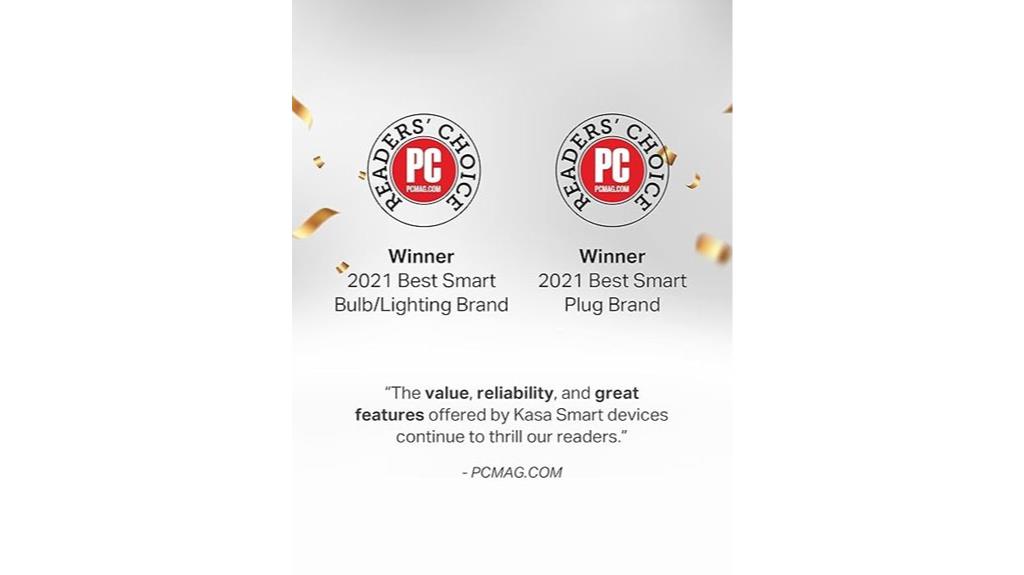
The Kasa Smart Plug Mini with Energy Monitoring (KP115) stands out as an excellent choice for anyone wanting to track their energy use alongside convenient remote control. It connects easily via 2.4GHz Wi-Fi, requiring no hub—just plug in and set up through the Kasa app. Compatible with Alexa, Google Home, and IFTTT, it offers voice control for hands-free operation. With safety features like overheating protection, fireproof shell, and a sliding safety cover, it’s built for security. Trusted by over 5 million users and backed by a 2-year warranty, this smart plug combines ease of use, safety, and energy management in one compact device.
Best For: those seeking an easy-to-use, energy-monitoring smart plug compatible with voice assistants for remote control and energy management.
Pros:
- Easy setup with 2.4GHz Wi-Fi and no hub required
- Compatible with Alexa, Google Home, and IFTTT for voice control
- Includes safety features like overheating protection and fireproof shell
Cons:
- Limited to 2.4GHz Wi-Fi networks, not compatible with 5GHz bands
- May require the Kasa app for setup and management, which could be an extra step for some users
- Energy monitoring features may require app updates or subscriptions in some cases
Factors to Consider When Choosing Smart Plugs for Energy Monitoring

When choosing a smart plug for energy monitoring, I look at how well it integrates with my existing smart home ecosystem to keep everything seamless. I also consider the accuracy of its energy tracking, how easy it is to set up, and the control options it offers for automation. Ultimately, I check safety certifications and the materials used to guarantee the device is reliable and safe for long-term use.
Compatibility With Ecosystems
Choosing a smart plug that seamlessly integrates with your existing smart home ecosystem is essential for easy control and automation. I always check if the device supports platforms like Alexa, Google Home, Apple HomeKit, or SmartThings, ensuring smooth compatibility. It’s important to verify whether the smart plug works with your preferred voice assistant or app, making routine setup effortless. I also look for support of industry-standard protocols like Zigbee, Z-Wave, or Matter, as they improve interoperability across different brands and devices. Additionally, I confirm if energy monitoring features are compatible with my ecosystem’s automation options, such as scheduling or reporting. Finally, I consider whether the device allows offline control or local automation, especially if privacy or hub-based communication matters.
Energy Monitoring Features
Are you aware of how accurate and detailed a smart plug’s energy monitoring features are? When choosing one, look for real-time data updates, ideally second-by-second, to track your power use precisely. Many smart plugs offer historical usage tracking, helping you spot patterns over days or weeks, and some provide cost estimates based on your energy rates. Extensive insights through charts and graphs can reveal which appliances are most energy-hungry, enabling smarter decisions. Advanced features also support scheduling and automation to cut unnecessary consumption. Compatibility with billing or reward programs adds extra value by turning your energy data into tangible savings. Ultimately, the more accurate and comprehensive the monitoring, the better you can optimize your energy use and reduce costs.
Setup and Ease of Use
Setting up a smart plug for energy monitoring should be quick and hassle-free, so look for devices that offer one-step pairing or app-guided installation. The process should be straightforward, with clear instructions and simple prompts for connecting to your Wi-Fi network. Preferably, choose a device compatible with your 2.4GHz Wi-Fi to avoid connection issues common with dual-band routers. The mobile app should be user-friendly, allowing easy device naming, scheduling, and timer setup without frustration. Additionally, reliable offline control options, like LAN control, help simplify daily use even if your internet drops. Devices with quick response times and simple setup steps make managing your energy-consuming devices effortless, ensuring you spend less time configuring and more time saving energy.
Control and Automation Options
When selecting a smart plug for energy monitoring, it’s important to take into account its control and automation features, as these can greatly improve your energy management. Advanced control options like scheduling, timers, and automation routines help optimize device operation and reduce waste. Voice control compatibility with platforms like Alexa, Google Assistant, and Siri allows for hands-free management, making it easy to turn devices on or off. Many models support remote access through mobile apps, so you can monitor and control appliances from anywhere. Integration with your smart home ecosystem enables scene creation—for example, turning off devices when leaving home or during specific times. Some smart plugs even include manual override buttons, providing local control during internet outages or app issues.
Safety Certifications and Materials
Choosing a safe smart plug starts with inspecting the materials and safety certifications. I look for devices made from flame-retardant materials like V0-rated plastics, which help prevent fires if overheating occurs. It’s also essential to confirm the smart plug has reputable safety certifications such as UL, ETL, or FCC, showing it meets strict safety and electromagnetic standards. I check that the device includes features like surge protection, overload safeguards, and short-circuit prevention to protect connected appliances. Durability matters too; I prefer plugs with heat-resistant materials that reduce the risk of melting or fire hazards over time. Finally, I verify that safety certifications are current and issued by recognized organizations, giving me confidence in the device’s compliance and safety during everyday use.
Size and Design Considerations
Selecting the right smart plug involves considering its size and design to make certain it fits well in your space. Compact, low-profile models prevent blocking adjacent outlets, allowing you to use multiple plugs simultaneously. The size should match your outlet’s available space to ensure compatibility without crowding or awkward fits. Rounded or flat shapes maximize space efficiency and minimize interference with nearby devices or furniture. Larger or bulkier designs can restrict access to neighboring outlets or require adapters, which complicate setup. A lightweight, streamlined design also enhances portability and makes installation easier across different environments. Overall, paying attention to size and shape helps you choose a smart plug that’s both functional and unobtrusive, fitting seamlessly into your home or office setup.
Frequently Asked Questions
How Do Smart Plugs With Energy Monitoring Impact Overall Electricity Bills?
Smart plugs with energy monitoring help me track how much power my devices use, so I can identify energy hogs and cut down on unnecessary consumption. By easily turning off devices when not in use and optimizing usage, I notice my electricity bills decrease over time. It’s a simple way to save money and reduce my environmental impact, making my home more efficient without much effort.
Are Energy Monitoring Features Compatible With All Smart Home Ecosystems?
I’ve found that energy monitoring features aren’t always compatible with every smart home ecosystem. It really depends on the brand and the platform you’re using. Some smart plugs work seamlessly with Alexa or Google Home, but others might only connect via their own apps. I recommend checking compatibility before buying to guarantee the energy monitoring feature integrates smoothly into your existing setup.
What Security Measures Protect Smart Plug Data From Hacking?
When it comes to protecting smart plug data from hacking, I always look for devices with strong security measures. I prioritize smart plugs that use encryption, secure Wi-Fi protocols, and regular firmware updates. I also make sure my home network has a strong password and enable two-factor authentication if available. These steps help me keep my data safe and my smart home secure from potential threats.
Can Energy Data Be Integrated Into Existing Home Energy Management Systems?
Did you know that over 60% of homeowners are interested in integrating smart device data into their existing home energy systems? When it comes to energy data, I’ve found that most smart plugs can indeed sync with popular home management platforms like Google Home or Amazon Alexa. This means you can monitor and control energy use seamlessly, making it easier to save power and optimize your home’s efficiency.
How Accurate Are the Energy Consumption Readings on These Smart Plugs?
When it comes to energy consumption readings on smart plugs, I find they’re generally quite accurate for everyday use. I’ve tested a few models, and most provide reliable data within a small margin of error. While they might not be perfect for precise measurements, they’re excellent for tracking overall power usage and identifying energy-hungry devices. I’d recommend choosing reputable brands to guarantee you get the most accurate readings.
Conclusion
After exploring these smart plugs, I realize how seamlessly they can fit into our daily routines, helping us save power without much effort. It’s funny how a simple device can make such a difference, almost like finding a forgotten $20 in your pocket. Whether you’re tech-savvy or just starting out, these options genuinely make energy monitoring easy and accessible. Trust me, once you try one, you’ll wonder how you ever managed without it.
